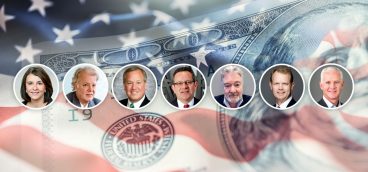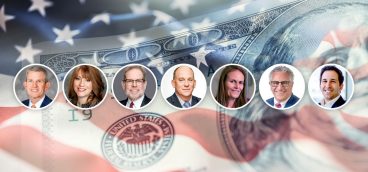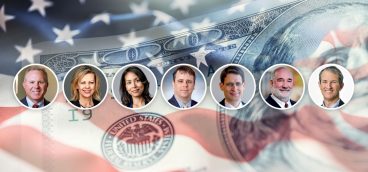Three Simple Questions on the Markets, Part II

We asked a group of the region’s leading wealth managers to pen a response to three questions about the markets and how they approach current conditions. Below are their answers to the second question: The Fed is working to “normalize” interest rates over the course of 2017. What impact will a more normal rate environment have on the stock and bond markets?
James Armstrong, Henry H. Armstrong Associates: Since the financial crisis of 2008, we’ve lived in a never-before world of 8 years of interest rates near zero, driven by artificial actions by the Federal Reserve and other central banks. No one really knows how this movie ends. But as interest rates rise, businesses and projects which became addicted to cheap credit will suffer. Risky assets may find few buyers. Bonds will decline in price. And companies that have been holding large cash balances at zero return will see earnings growth as they start to earn interest on their large cash balances. Doubtless there will be other consequences that can’t be foreseen. This argues for investment strategies that can prosper under a wide range of outcomes.
Elizabeth Genter, Schenley Capital: The Federal Funds Rate is the cost that banks are charged for borrowing money from the Federal Reserve Bank. An increase in the Federal Funds Rate attempts to shrink the supply of money available for purchasing goods, by making money more expensive. The banks lend us money at an interest rate based on the Prime Rate, and that rate increases as the Federal Funds Rate increases. We have been living in a low interest rate environment and this has encouraged spending, on houses, automobiles, etc. Banks, insurance and mortgage companies will benefit. There is a rule of thumb that when the Fed raises rates the equity market retreats, although, recently, the market has welcomed the rate hikes. This, combined with recent earnings growth, has supported the stock market expansion and the interest rate paid to bond holders will increase.
Linda Duessel, Federated Investors: Normal is good. We’ve been anything but—0% rates for seven years wasn’t normal, nor are such low rates at this stage of an expansion. Considering that there was a full year between the first two hikes, that the increases have come off unprecedented lows and that it takes five years on average from the start of a rate-hike cycle to the next recession, one could argue there’s nothing to worry about. Debating whether we get 1, 2 or even 3 more hikes this year is almost irrelevant. We’ve got time. Historically the clock doesn’t start ticking on the next downturn until the yield curve inverts, i.e., long rates fall below short rates. Right now, the curve is relatively steep. That’s good for stocks.
Gregory J. Sorce, HBKS Wealth Advisors: After an eight-year bull market, stock valuations are high by most measures, and interest rates are still near historical lows. Most Fed watchers expect two more rate hikes this year, and for the Fed to continue increasing rates slowly over the next few years. Stock and bond markets are likely to generate returns below their historical averages the next few years, but any correction in stocks is likely to be short-term in nature. Stocks markets may provide returns in the mid-single digits and bond markets may be able to generate returns in the low-single digits.
Henry S. Beukema III, Guyasuta Investment Advisors: For equity investors, gradual interest rate increases due to an expanding economy and accompanied by accelerating earnings growth has historically been positive for stock performance. However, current valuations are not inexpensive at a 17-18x forward earnings multiple vs. a historical average of 15x. Irrespective of Fed tightening, with the macroeconomic and geopolitical uncertainties along with current stock valuations, we are moderately cautious with respect to equity markets. For fixed income investors, interest rate risk can be managed through building laddered portfolios of individual bonds with target durations in the 4-7 year range.
Peter F. Mathieson, Fairview Capital Investment Management: We view the Federal Reserve Bank’s efforts quite positively. The Fed actually took the first step toward normalization back in 2013 when it announced plans to curtail the monthly purchases of mortgage bonds (remember “QE”, quantitative easing?). Since then the Fed has raised rates modestly three times over nearly a year and a half. With sufficient time to process these changes and consider implications for the future, the stock and bond markets have performed quite well. Looking ahead, stocks could continue to appreciate, supported by the same improvement in fundamentals that are leading the Fed to increase rates. Counterintuitively, bonds could also fare decently as greater investor demand—sparked by the appeal of higher interest rates—offsets the traditional price decline expected from those higher rates.
H. Scott Cunningham, PNC Wealth Management: Any increase in the “risk free” rate of return—customarily the yield on government bonds such as U.S. Treasuries—will negatively impact the price of stocks and bonds. The relationship is inverse—as interest rates rise, the current value of the asset goes down. The other part of the equation is earnings. If earnings continue to grow, then the impact of a rising “risk free” rate will be lessened.
Joseph Scarpo, Private Wealth Advisors: Interest rate normalization occurs because the Federal Reserve concludes that the economy is strong enough to support higher rates. That conclusion suggests that economic expansion will continue despite higher interest rates. Higher mid- and longer-term rates will result in losses in bond values. Those losses are predictable and can be estimated by looking at the duration of a bond portfolio. A rising rate environment will not benefit bonds in the short term. The stock market over time represents the cumulative profit growth of the listed companies. Economic expansion should lead to profit growth and therefore a stock market that provides positive inflation-adjusted returns. Long-term investors should look past the rate hikes and focus on the expansion. Increased profitability should equate to higher equity valuations.
Thomas L. Wentling Jr., Wentling Tarquinio Loughney Wealth Consulting Group, UBS Financial Services Inc.: Higher interest rates are normally a headwind to stocks and bonds, but not necessarily this time. As the Fed begins to loosen its reins, interest rates will be free to seek their natural level—a result of Adam Smith’s 1759 “invisible hand” of market forces theory. He believed millions of individuals freely seeking to maximize their own self-interest would always know more than any subset of “more knowledgeable” people. Higher interest rates, the result of increased demand for money, will both more fairly compensate savers and signal entrepreneurs that there is demand for products and services profitably provided. Individual market participants, haggling over how much to pay for stocks and bonds, will determine fair value. Less regulation and taxes, ALL ELSE EQUAL, would argue pink sky at night…
John Augustine, Huntington Bank: The Fed will be key to the price-to-earnings multiple on stocks and shape of the treasury yield curve in the second half of the year. Currently, markets expect the Fed to raise the Fed Funds rate two more times this year—once in June and again between September and December. If the Fed becomes more aggressive to normalize interest rates, then the price-to-earnings multiple on stocks and shape of the yield curve are both likely to fall, which would not generally be a scenario that investors have in their projections this year.
Gregory Curtis, Greycourt & Co.: Since the Fed is well behind the markets in responding to economic growth and optimism, only a too-aggressive raising of rates could have much impact. Rates of 2½% on the 10-year Treasury seem about right to me, rather than the much higher rates many observers predict. In fact, the Fed seems to have bought into that hoary nugget, “secular stagnation,” which means that it will continue to be as wrong about the economy looking forward as it has been looking back. Since the Financial Crisis, nothing has mattered except the central bankers. Going forward, few things will matter less.
Michael R. Foster, BNY Mellon Wealth Management: If the Fed increases rates at a moderate pace, which we expect, we believe that stocks will continue to grind higher this year. Historically stocks have done well in a moderately rising rate environment, which suggests stronger economic growth coupled with well-anchored inflation expectations. Although there will be some principal erosion in fixed rate bonds as rates rise moderately over the next 12 to 18 months, this may be offset by income. In this environment, higher yielding bonds, both fixed and floating rate, should continue to provide positive returns.





